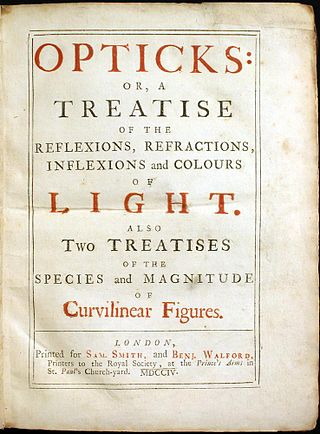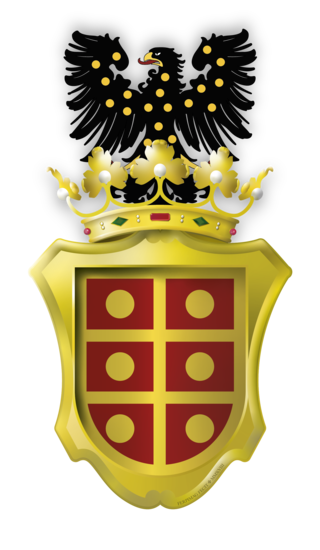
A set of primary colors or primary colours consists of colorants or colored lights that can be mixed in varying amounts to produce a gamut of colors. This is the essential method used to create the perception of a broad range of colors in, e.g., electronic displays, color printing, and paintings. Perceptions associated with a given combination of primary colors can be predicted by an appropriate mixing model that reflects the physics of how light interacts with physical media, and ultimately the retina.

Opticks: or, A Treatise of the Reflexions, Refractions, Inflexions and Colours of Light is a book by English natural philosopher Isaac Newton that was published in English in 1704. The book analyzes the fundamental nature of light by means of the refraction of light with prisms and lenses, the diffraction of light by closely spaced sheets of glass, and the behaviour of color mixtures with spectral lights or pigment powders. Opticks was Newton's second major book on physical science and it is considered one of the three major works on optics during the Scientific Revolution. Newton's name did not appear on the title page of the first edition of Opticks.

Lamego is a city and municipality in the Viseu District, in the Norte Region of the Douro in northern Portugal. Located on the shores of the Balsemão River, the municipality has a population of 26,691, in an area of 165.42 km2.

João Baptista da Silva Leitão de Almeida Garrett, 1st Viscount of Almeida Garrett was a Portuguese poet, orator, playwright, novelist, journalist, politician, and a peer of the realm. A major promoter of theater in Portugal he is considered the greatest figure of Portuguese Romanticism and a true revolutionary and humanist. He proposed the construction of the D. Maria II National Theatre and the creation of the Conservatory of Dramatic Art.

Alexandre Herculano de Carvalho e Araújo was a Portuguese novelist and historian.

Theory of Colours is a book by Johann Wolfgang von Goethe about the poet's views on the nature of colours and how they are perceived by humans. It was published in German in 1810 and in English in 1840. The book contains detailed descriptions of phenomena such as coloured shadows, refraction, and chromatic aberration. The book is a successor to two short essays titled "Contributions to Optics".

Hatching is a conventional system for monochrome denotation of heraldic armory, whereby the tinctures (colours) are represented by dots and lines. This technique is employed in cases where colours, for either aesthetic, practical or economic reasons are not reproduced – e.g. on surfaces such as woodcuts or engravings, seals and coins.
On Vision and Colors is a treatise by Arthur Schopenhauer that was published in May 1816 when the author was 28 years old. Schopenhauer had extensive discussions with Johann Wolfgang von Goethe about the poet's Theory of Colours of 1810, in the months around the turn of the years 1813 and 1814, and initially shared Goethe's views. Their growing theoretical disagreements and Schopenhauer's criticisms made Goethe distance himself from his young collaborator. Although Schopenhauer considered his own theory superior, he would still continue to praise Goethe’s work as an important introduction to his own.

Marquess of Lavradio is a Portuguese title of nobility created by Letters Patent of King José I of Portugal on 18 October 1753 for D. António de Almeida Soares de Portugal, 1st Count of Lavradio and 4th Count of Avintes.
Miguel António de Sousa Horta Almeida e Vasconcelos, 2nd Baron of Santa Comba Dão was a Portuguese nobleman.

Olavo Luiz Pimentel de Carvalho was a Brazilian polemicist, self-proclaimed philosopher, political pundit, former astrologer, journalist, and far-right conspiracy theorist. From 2005 until his death, he lived near Richmond, Virginia, in the United States.

Paulo Bernardo Silva is a Brazilian politician, member of the Workers' Party (PT). He was Minister of Communications during the government of Dilma Rousseff and Minister of Planning during the government of Luiz Inácio Lula da Silva.
Doce Tentação is a Portuguese telenovela that started airing on TVI on 8 January 2012 and stopped broadcasting on March 9, 2013. This telenovela was authored by Sandra Santos, from Casa da Criação, a group of soap opera/series authors of Plural Entertainment. The slogan of this telenovela is "Love that bears fruit, sows envy!". The protagonists are Mariana Monteiro, Diogo Amaral, Pedro Barroso and Sofia Ribeiro.
The 2013 Campeonato Paulista de Futebol Profissional da Primeira Divisão - Série A1 was the 112th season of São Paulo's top professional football league.
The 2013–14 Segunda Liga, also known as the Liga Revolução by Cabovisão for sponsorship reasons, was the 24th season of the second-tier of football in Portugal. A total of 22 teams played in the league in this season.
Diogo Miguel Alves Luís is a Portuguese retired footballer who played as a left back.

Events in the year 1911 in Brazil.
Ouro Verde is a Portuguese telenovela broadcast and produced by TVI, written by newcomer Maria João Costa. It is recorded in Portugal and Brazil with some scenes also recorded in Madrid.

Cara e Coragem is a Brazilian telenovela produced and broadcast by TV Globo, that aired from 30 May 2022 to 13 January 2023. The telenovela is created by Claudia Souto and written by her with Isadora Wilkinson, Julia Laks, Wendell Bendelack, and Zé Dassilva. It stars Paolla Oliveira, Marcelo Serrado, and Taís Araújo.

Por Ti is a Portuguese telenovela produced by SP Televisão and broadcast by SIC. It premiered on 7 March 2022. The telenovela is an idea of Artur Ribeiro developed by Alexandre Castro and written too by Alexandre Castro and Joana Andrade, Ana Lúcia Carvalho, Andreia Vicente Martins, Cândida Ribeiro, Filipa Poppe and Manuel Carneiro. It stars Filipa Areosa, Lourenço Ortigão, Rita Blanco, Dalila Carmo, Sandra Faleiro, João Reis, Luís Esparteiro and Duarte Gomes.














